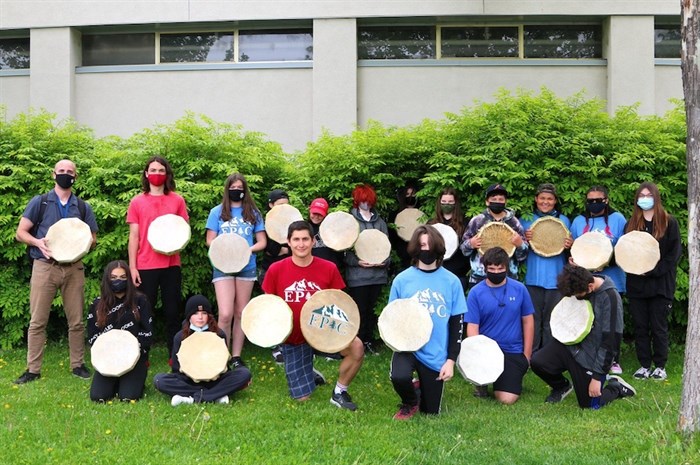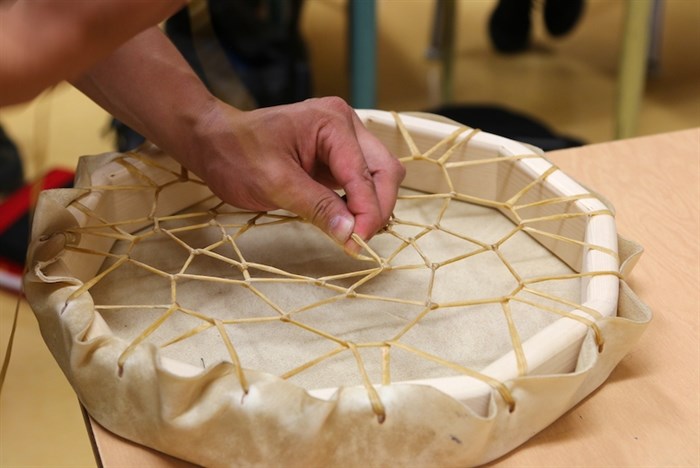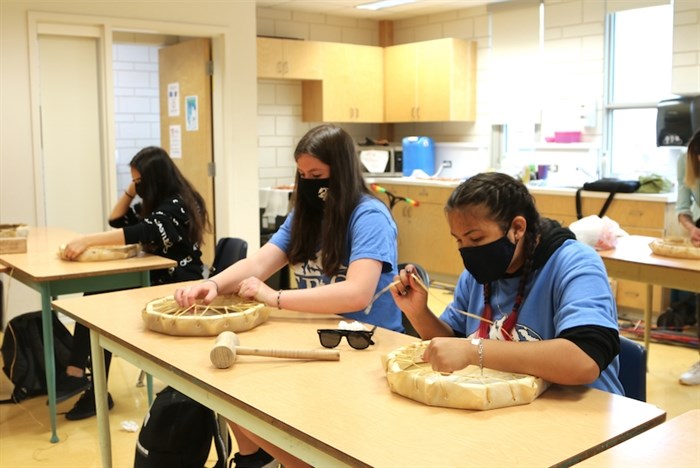
“I haven't been able to really deep dive into my culture and my identity until I became a teacher,” says Ryan Baptiste.
Image Credit: Athena Bonneau, Local Journalism Initiative
May 20, 2021 - 6:00 PM
The Experiential, Project-based, Indigenous and Community (EPIC) program designed to strengthen connections with Indigenous students and boost attendance at a high school in Oliver seems to be working.
The new program is offered to Indigenous and non-Indigenous students at Southern Okanagan Secondary School (SOSS) in Syilx/Okanagan territory.
“We noticed that our Aboriginal students were dropping out of school and not graduating. So we wanted to try and engage them more,” says Ryan Baptiste, who’s been teaching the EPIC program at SOSS for six years.
Prior to launching EPIC in 2015, only 49 per cent of the district’s Indigenous students were graduating at the five-year completion rate, while non-Indigenous students had a five-year completion rate of 79 per cent, according to the 2019-2020 Aboriginal How Are We Doing Report.
By 2020, the five-year school completion rate for Indigenous students in SD53 had increased to 69 per cent.
“We are hoping to get our Indigenous graduation rates even higher this year,” says Baptiste.
‘Embracing my identity as a Syilx man’
Baptiste is Syilx and a member of the Osoyoos Indian Band.
In 2015, he was asked by the principal at SOSS if he’d like to help create a new program for Indigenous kids that was “land-based, hands-on, and just something different to try to get kids more engaged,” he says.
“I was only just finishing my second year of teaching at the time, so I was a brand new teacher. For me it was just something new,” says Baptiste.
The EPIC program is cross-curricular. Through hands-on projects, students learn math, English, woodworking and health concepts while also learning Syilx Okanagan teachings.
Upon completing the EPIC program, students receive credits for Math 9, English 9, ADST Woodwork 9, and Physical and Health Education 9.
“I was looking at how I could tie in First Nations context and history and culture into the program, looking at land based learning opportunities. I learned I can do a lot of different things in different seasons,” says Baptiste.
In the spring, for example, he gets students to make their own speetlum digging sticks in wood shop, Baptiste says. Then he takes them out on the land to test their sticks out on the speetlum, a Syilx traditional plant also known as bitteroot.
The program focuses on Syilx teachings because the majority of the students are Syilx, says Baptiste.
“This is where we’re from,” says Baptiste, “Bringing that connection and culture to them is really nice.”
He says teaching the program has prompted him to embrace his identity as a Syilx man and dive deeper into his culture.
“Researching and talking to various people and just like learning about different things has been really awakening for me,” he says.
Baptiste says he hopes to teach the students that “learning can happen anywhere.”
“It’s like what they’ve experienced in school isn’t the only way to learn,” he says.
“I try to make it an experiential learning experience for them to show what they’ve learned in different ways. For some students, it allows them to show different strengths that they haven’t been able to showcase.”
‘This is a really good opportunity’
Kaylee Klessen says this way of learning has helped her flourish in her academics.
“I’ve had the problem with the teachers not realizing I’m dyslexic, and Mr. Baptiste is very understanding,” she says. “He knows that I’m going to need help or a little extended time. This program is great for me,” says the grade nine student.
On May 12, students spent the day attaching rawhides to drum frames they made two weeks prior. For the final stage, they did a dreamcatcher-style weave with sinew into the drum frames.
“These involve polygons and shapes,” says Baptiste. “We could look at like angles and surface areas … or how big of a piece of hide you’re going to need for a drum size this big.”

“We’re going to teach the students how to sing and drum the Okanagan song,” says Baptiste.
Image Credit: Athena Bonneau, Local Journalism Initiative
This wasn’t Tyler Sky Louie’s first time making a drum.
“I made one drum after another,” she says. “It gets easier and yeah, your hands will go raw and red, but in the end, it’s worth it because you got a nice-sounding drum and something you can give away.”
“The best part is when it’s done. It’s like the sound of your mother’s heartbeat or your heartbeat, when you drum.”
Asked why she enrolled in the EPIC program, Louie says it’s kind of a tradition for her family.
“My brother and all my older cousins went into EPIC. This is a really good opportunity,” says Louie, who is an Osoyoos Indian Band member.
She says it’s important to her to be learning about her own culture and traditions because not many schools offer a class where she can learn Syilx Okanagan teachings.

Klessen (left) and Louie (right) tie the skins onto their frames on May 12, 2021.
Image Credit: Athena Bonneau, Local Journalism Initiative
“This course is helping me to reconnect to my Indigenous roots. My parents are really happy with me doing this program,” Louie says.
“I’m hoping in some way that my little cousin will go to EPIC.”
‘An all-around amazing environment’
While the program was initially designed for Indigenous students, Baptiste says they opened it up to non-Indigenous students, too, because they felt “this style of teaching was just good pedagogy and could benefit anybody.”
“It wasn’t something that was really taught in my elementary school,” Devon Roger, a grade 12 student who took the EPIC program in 2019, says. “I checked out every year until the year that I was eligible to do it.”
While in the program, Roger says he made rattles out of deer hide and hiked to see pictographs from hundreds of thousands of years ago.
“One of the most valuable things to me that I learned from EPIC was … if you help someone, they will help you in return. Whether it’s the next day or the week after, they will give you that help.”
“Learning about the Indigenous community and what they mean and how they help us really shaped the respect I have for Indigenous people,” Rogers said.
Baptiste says he loves hearing from former students about the program’s lasting impacts.
“To do something different with the students and … hearing stories from ex-students or from friends and family of the students saying. This class made such a difference for my child’ … makes it feel like I’m doing the right thing as a teacher.”
— This story was originally published by The Discourse and IndigiNews.
News from © The Canadian Press, 2021